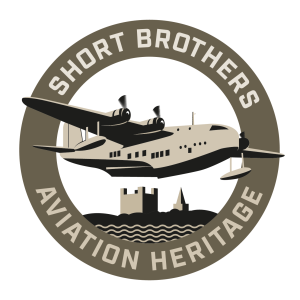
1917 – 1947
SHORTS BOYS | These are the men, women and boys who worked for Short Brothers
LOUIS BROWN... by himself
“When I was nine years old I was fascinated by a cutaway drawing of the first Short ‘Empire’ flying boat spread across the centre of my boys’ paper ‘Modern Wonder’ in 1936. My ambition from then on was to become a Shorts apprentice.
In the spring of 1943, nearing the end of my schooling, I wrote to the firm at Rochester asking to be considered for an apprenticeship, not knowing at that very time that an ill-informed [government] minister, Stafford Cripps, was in the process of nationalising the firm and treating Oswald Short in an incredibly and unnecessarily rude and hurtful manner. I received no reply even after a second letter.
Fortunately, I had elderly relatives in Cambridge who told me that Shorts had established a repair factory for Stirling bombers on the outskirts of the town and suggested I went there in person to ask for an apprenticeship. This I did but had to fight my local Ministry of Labour to get a transfer from Oxfordshire to Cambridge.
Eventually, this was allowed and I was taken on as a 16-year-old employee. Luckily the head inspector, a Shorts’ man from Rochester, thought I was worth an apprenticeship and made the apprentice supervisor come from Rochester to sign me on.
After the war Shorts brought me down to Rochester to work on the ‘Shetland’, our largest flying boat. Due once again to Stafford Cripps the firm was moved over to our ‘daughter’ company Short and Harland, Belfast, where I spent the last year of my apprenticeship.
Instead of continuing with the firm, which they wanted me to do, I returned to Cambridge to court and marry a girl I had met while working at S.E.B.R.O [ Repair Organisation] the repair factory.
Sadly, the only original member of Short’s fabulous aeronautical team that I met was P.M. Jones, the worlds’ first aeronautical draughtsman, with whom I discussed the importance of preserving the many early drawings which he was looking after as Head of Drawings Library at Rochester”.
In February 2016 Louis added the following to his ‘story’…
Oswald insisted that apprentices study metallurgy…
a. The art of working metals especially of extracting metals from their ores.
b. Descriptive science of the internal structures of metals.
This knowledge of metallurgy led Louis to obtain employment in later life, once he left Shorts, after the war because the skill he had learnt was ‘spotted’ on his CV.
When Louis and his apprentice friend, Ken Bowyer, were relocated to Rochester in 1946, they met Mary Smith (daughter of Hector Smith, the Company chauffer). They were all members of the Youth Hostels Association cycling group. Louis and Ken were looking for lodgings and Mary suggested the flat above her mother Edith’s haberdashery shop in Chatham. Mary and Ken subsequently married.
[Editor The search is on for Hector’s photograph, stood by the car, in his uniform]
SHORT BROTHERS C.R.O. Madingley Road, Cambridge
Lou Brown was a SHORT BOY (men, women and boys who worked for Shorts. His first work encounter as an apprentice was with SEBRO Ltd, a wholly owned subsidiary of Short Brothers (Rochester and Bedford) Ltd. that was incorporated in 1940 to run Shorts’ C.R.O. ( Civilian Repair Organisation) in offices requisitioned at Trinity College Cambridge, in support of their four-engined heavy bomber the STIRLING, the ONLY heavy bomber ready at the start of World War 2.
Sebro’s presence in Cambridge was at two sites. There was a factory on the Madingley Road on the western outskirts of the City and a flight-line based at the R.A.F. airfield at Bourn, to the north-west.
The system was to send a SEBRO working party to the R.A.F. airfield to dismantle battled-damaged Stirlings, load the on to (nicknamed) ‘Queen Mary’s’ – a low-loader trailer and transport the recovered instruments and body parts to the Madingley Road factory for further use.
It is said that the first job of the foreman was to hose the parts to ensure there were no human remains in/on the wrecked components so as not to alarm the female workforce.
MADINGLEY ROAD FACTORY ...
The factory was built on land requisitioned from St. John’s College, Cambridge; Merton College, Oxford and Storey’s Charity (a major Cambridge aid organization).
[Editor’s Note: There was considerable local opposition to this requisition that brought with it the risk of permanent industry within the Town boundary. See following letter from G.M. Trevelyan)
We do not have details but it is evident that the Madingley Road site was taken into U.K. Government ownership; the main hangar was still there in the 1960’s and the site was redeveloped in the 1970-‘s as the headquarters of the British Antarctic Survey organisation – a Government Agency.
R.A.F. BOURN SITE...
There are documents that, after SEBRO became redundant and was ‘wound-up’, show the site was leased to FISON, a local agricultural company, from 1945-1958.
Between March 1958 and February 1964, the site and buildings were leased by The Secretary of State for Air, to Marshalls who subsequently sold them, in 1972.
Both sites were vacated, and a farewell-dinner was held at The Dorothy, Sidney Street Cambridge on 17th April 1946.
[EDITOR: Acknowledgement to…
Mr. Gordon Bruce, Company Secretary of Short Brothers and Harland, BELFAST.
Lou Brown, Short Brothers apprentice and later College Lecturer in Metalurgy.
SHORTS BOYS
- ROBERT BOORMAN
- LOUIS BROWN
- PATRICK BRYANT
- BETTE CROWTHER
- ARTHUR HENRY CROWE
- VICTOR WILLIAM KENNETH DAY
- WILLIAM FOREMAN
- STEPHEN FOY
- FREDERICK GIBBS
- GORDON E HUXTED
- RONALD LAMB
- GEORGE & NANCY LEWING
- WILLIAM MASON
- ZENA F. NEAL
- FREDERICK QUITTENDEN
- JACK RALPH
- EWART RAYNER
- HILDA ROE
- DAVID SMITH
- WILLIAM WELLER
- WINFRED WELLER
- HARRY JAMES WOOLLEY


